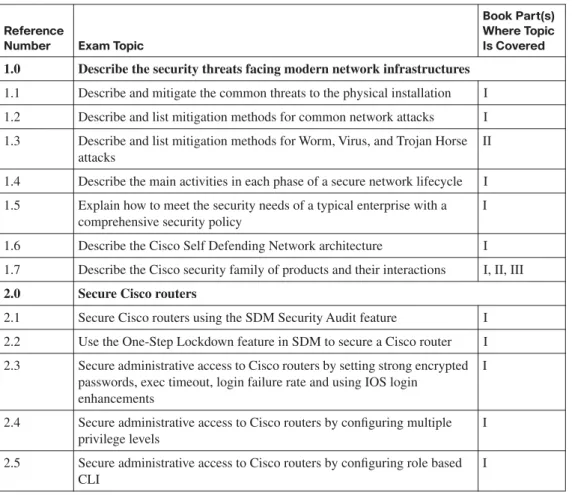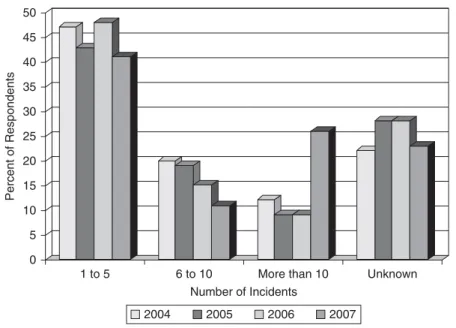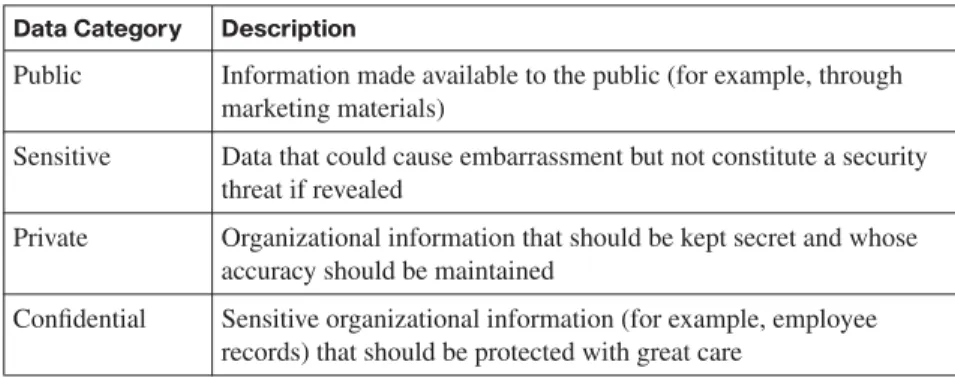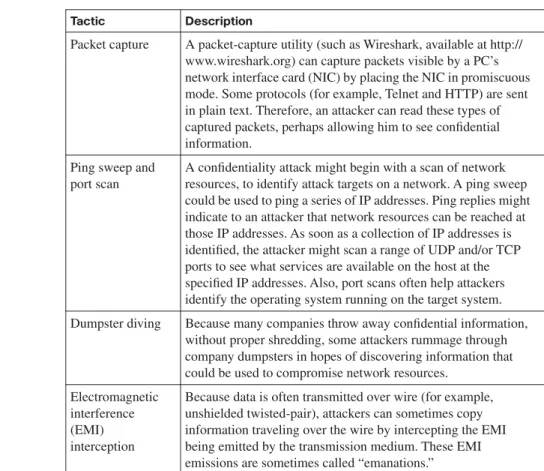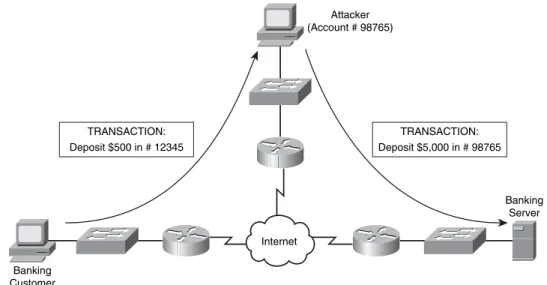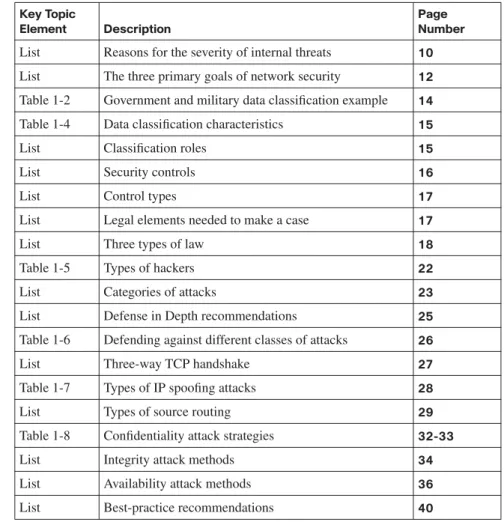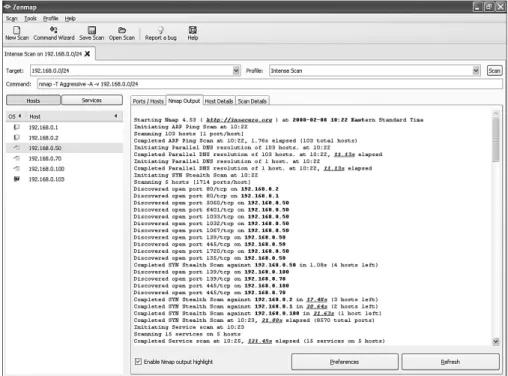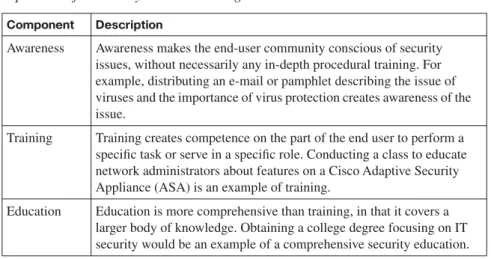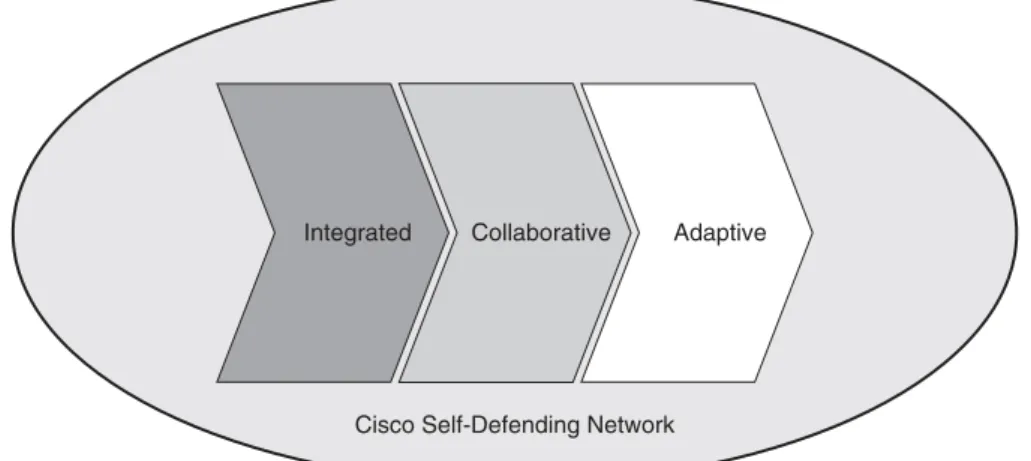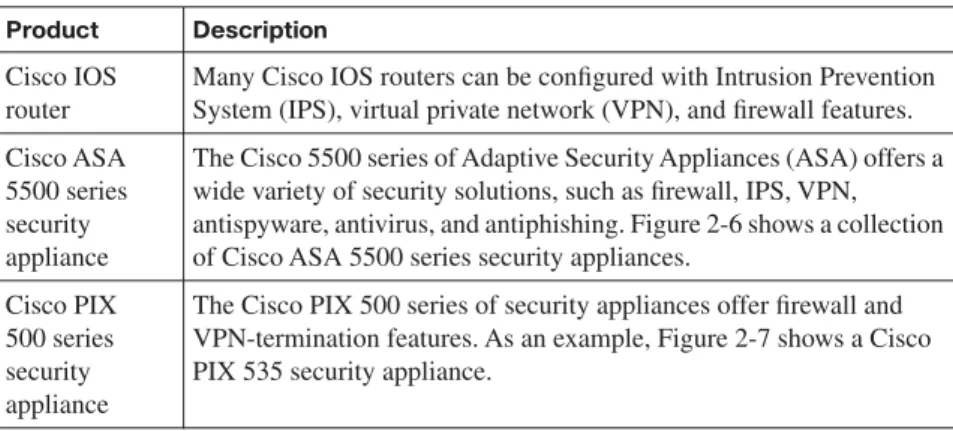800 East 96th Street Indianapolis, IN 46240 USA
Cisco Press
Official Exam Certification Guide
CCNA Security Official Exam Certification Guide Michael Watkins
Kevin Wallace, CCIE No. 7945 Copyright© 2008 Cisco Systems, Inc. Published by:
Cisco Press 800 East 96th Street Indianapolis, IN 46240 USA
All rights reserved. No part of this book may be reproduced or transmitted in any form or by any means, electronic or mechanical, including photocopying, recording, or by any information storage and retrieval system, without written permission from the publisher, except for the inclusion of brief quotations in a review.
Printed in the United States of America First Printing June 2008
Library of Congress Cataloging-in-Publication data is on file. ISBN-13: 978-1-58720-220-9
ISBN-10: 1-58720-220-4
Warning and Disclaimer
This book is designed to provide the information necessary to be successful on the Cisco IINS (640-553) exam. Every effort has been made to make this book as complete and accurate as possible, but no warranty or fitness is implied. The information is provided on an “as is” basis. The authors, Cisco Press, and Cisco Systems, Inc. shall have neither liability nor responsibility to any person or entity with respect to any loss or damages arising from the information contained in this book or from the use of the discs or programs that may accompany it.
The opinions expressed in this book belong to the authors and are not necessarily those of Cisco Systems, Inc.
Trademark Acknowledgments
Corporate and Government Sales
Cisco Press offers excellent discounts on this book when ordered in quantity for bulk purchases or special sales. For more information, please contact:
U.S. Corporate and Government Sales
1-800-382-3419 [email protected] For sales outside of the U.S. please contact: International Sales
Feedback Information
At Cisco Press, our goal is to create in-depth technical books of the highest quality and value. Each book is crafted with care and precision, undergoing rigorous development that involves the unique expertise of members of the profes-sional technical community.
Reader feedback is a natural continuation of this process. If you have any comments about how we could improve the quality of this book, or otherwise alter it to better suit your needs, you can contact us through e-mail at [email protected]. Please be sure to include the book title and ISBN in your message.
We greatly appreciate your assistance.
Publisher: Paul Boger Cisco Press Program Manager: Jeff Brady Associate Publisher: Dave Dusthimer Copy Editor: Gayle Johnson
Executive Editor: Brett Bartow Technical Editors: Ryan Lindfield and Anthony Sequeira Managing Editor: Patrick Kanouse
Development Editor: Andrew Cupp Senior Project Editor:Tonya Simpson Editorial Assistant:Vanessa Evans Book and Cover Designer: Louisa Adair Composition:Mark Shirar
About the Authors
Michael Watkins, CCNA/CCNP/CCVP/CCSP, is a full-time senior technical instructor with SkillSoft Corporation. With 13 years of network management, training, and consulting experience, he has worked with organizations such as Kraft Foods, Johnson and Johnson, Raytheon, and the U.S. Air Force to help them implement and learn about the latest network technologies. In addition to holding more than 20 industry certifications in the areas of networking and programming technologies, he holds a bachelor of arts degree from Wabash College.
Kevin Wallace, CCIE No. 7945, is a certified Cisco instructor working full time for SkillSoft, where he teaches courses in the Cisco CCSP, CCVP, and CCNP tracks. With 19 years of Cisco networking experience, he has been a network design specialist for the Walt Disney World Resort and a network manager for Eastern Kentucky University. He holds a bachelor of science degree in electrical engineering from the University of Kentucky. He is also a CCVP, CCSP, CCNP, and CCDP, with multiple Cisco security and IP communications specializations.
About the Technical Reviewers
Ryan Lindfield is an instructor and network administrator with Boson. He has more than ten years of network administration experience. He has taught many courses designed for CCNA, CCNP, and CCSP preparation, among others. He has written many practice exams and study guides for various networking technologies. He also works as a consultant, where among his tasks are installing and configuring Cisco routers, switches, VPNs, IDSs, and firewalls.
Dedications
For their support and encouragement throughout this process, I dedicate my contribution to this book to my family.
—Michael
I dedicate my contribution to this book to my best friend (and wife of 14 years), Vivian. —Kevin
Acknowledgments
From Michael Watkins:
I want to thank the team at Cisco Press for their direction and support throughout the writing process. For their support and encouragement throughout this process, I wish to thank and acknowledge Tom Warrick and the instructor team at SkillSoft. I also wish to thank Kevin Wallace, who brought his talent and experience to this project and was an enormous help each step of the way.
Finally, I want to thank my family for their continued support through this project, especially my children, Abigail, Matthew, and Addison, who are always an inspiration in all that I do.
From Kevin Wallace:
I wish to express my sincere thanks to the team at Cisco Press. You guys are a class act, and I’m honored to be associated with you. Also, I give a huge thank-you to Michael Watkins for inviting me to participate in writing this book.
Contents at a Glance
Foreword xxvi Introduction xxviiPart I Network Security Concepts 3
Chapter 1 Understanding Network Security Principles 5 Chapter 2 Developing a Secure Network 45
Chapter 3 Defending the Perimeter 77 Chapter 4 Configuring AAA 111 Chapter 5 Securing the Router 155
Part II Constructing a Secure Infrastructure 205
Chapter 6 Securing Layer 2 Devices 207 Chapter 7 Implementing Endpoint Security 251 Chapter 8 Providing SAN Security 279
Chapter 9 Exploring Secure Voice Solutions 297
Chapter 10 Using Cisco IOS Firewalls to Defend the Network 319 Chapter 11 Using Cisco IOS IPS to Secure the Network 385
Part III Extending Security and Availability with Cryptography and VPNs 427
Chapter 12 Designing a Cryptographic Solution 429 Chapter 13 Implementing Digital Signatures 463
Chapter 14 Exploring PKI and Asymmetric Encryption 491 Chapter 15 Building a Site-to-Site IPsec VPN Solution 523 Part IV Final Preparation 589
Chapter 16 Final Preparation 577 Part V Appendixes 583
Appendix A Answers to “Do I Know This Already?” Questions 585 Appendix B Glossary 595
Appendix C CCNA Security Exam Updates: Version 1.0 617 Appendix D Memory Tables (CD only)
Contents
Foreword xxvi Introduction xxvii
Part I Network Security Concepts 3
Chapter 1 Understanding Network Security Principles 5 “Do I Know This Already?” Quiz 5
Foundation Topics 9
Exploring Security Fundamentals 9 Why Network Security Is a Necessity 9
Types of Threats 9 Scope of the Challenge 10
Nonsecured Custom Applications 11
The Three Primary Goals of Network Security 12 Confidentiality 12 Controls in a Security Solution 16 Responding to a Security Incident 17 Legal and Ethical Ramifications 18
Legal Issues to Consider 19
Understanding the Methods of Network Attacks 20 Vulnerabilities 20
Potential Attackers 21 The Mind-set of a Hacker 23 Defense in Depth 24
Understanding IP Spoofing 27
Launching a Remote IP Spoofing Attack with IP Source Routing 28
Launching a Local IP Spoofing Attack Using a Man-in-the-Middle Attack 29 Protecting Against an IP Spoofing Attack 30
Understanding Confidentiality Attacks 31 Understanding Integrity Attacks 33 Understanding Availability Attacks 36 Best-Practice Recommendations 40 Exam Preparation Tasks 41
Review All the Key Topics 41
Chapter 2 Developing a Secure Network 45 “Do I Know This Already?” Quiz 45 Foundation Topics 49
Increasing Operations Security 49 System Development Life Cycle 49
Initiation 49
Types of Backup Sites 56
Constructing a Comprehensive Network Security Policy 57 Security Policy Fundamentals 57
Risk Analysis, Management, and Avoidance 60 Quantitative Analysis 60
Qualitative Analysis 61 Risk Analysis Benefits 61
Risk Analysis Example: Threat Identification 61 Managing and Avoiding Risk 62
Factors Contributing to a Secure Network Design 62 Design Assumptions 63
Minimizing Privileges 63 Simplicity Versus Complexity 64 User Awareness and Training 64 Creating a Cisco Self-Defending Network 66
Evolving Security Threats 66
Constructing a Cisco Self-Defending Network 67 Cisco Security Management Suite 69 Cisco Integrated Security Products 70 Exam Preparation Tasks 74
Complete the Tables and Lists from Memory 75 Definition of Key Terms 75
Chapter 3 Defending the Perimeter 77 “Do I Know This Already?” Quiz 77 Foundation Topics 81
ISR Overview and Providing Secure Administrative Access 81 IOS Security Features 81
Cisco Integrated Services Routers 81 Cisco 800 Series 82
Limiting the Number of Failed Login Attempts 92 Setting a Login Inactivity Timer 92
Configuring Privilege Levels 93
Creating Command-Line Interface Views 93 Protecting Router Files 95
Enabling Cisco IOS Login Enhancements for Virtual Connections 96 Creating a Banner Message 98
Cisco Security Device Manager Overview 99 Introducing SDM 99
Preparing to Launch Cisco SDM 101 Exploring the Cisco SDM Interface 102 Exam Preparation Tasks 106
Review All the Key Topics 106
Complete the Tables and Lists from Memory 106 Definition of Key Terms 106
Command Reference to Check Your Memory 107
Chapter 4 Configuring AAA 111
“Do I Know This Already?” Quiz 111 Foundation Topics 115
Configuring AAA Using the Local User Database 115 Authentication, Authorization, and Accounting 115 AAA for Cisco Routers 115
Router Access Authentication 116
Using AAA to Configure Local User Database Authentication 117 Defining a Method List 119
Setting AAA Authentication for Login 120
Implementing the aaa authorization Command 122 Working with the aaa accounting Command 124 Using the CLI to Troubleshoot AAA for Cisco Routers 126 Using Cisco SDM to Configure AAA 127
Configuring AAA Using Cisco Secure ACS 128 Overview of Cisco Secure ACS for Windows 129
Additional Features of Cisco Secure ACS 4.0 for Windows 130 Cisco Secure ACS 4.0 for Windows Installation 132
Overview of TACACS+ and RADIUS 137 TACACS+ Authentication 138
Command Authorization with TACACS+ 140 TACACS+ Attributes 140
Authentication and Authorization with RADIUS 141 RADIUS Message Types 142
RADIUS Attributes 142 Features of RADIUS 143 Configuring TACACS+ 144
Using the CLI to Configure AAA Login Authentication on Cisco Routers 144 Configuring Cisco Routers to Use TACACS+ Using the Cisco SDM 146 Defining the AAA Servers 147
Exam Preparation Tasks 149 Review All the Key Topics 149
Complete the Tables and Lists from Memory 150 Definition of Key Terms 150
Command Reference to Check Your Memory 150
Chapter 5 Securing the Router 155 “Do I Know This Already?” Quiz 155 Foundation Topics 158
Locking Down the Router 158
Identifying Potentially Vulnerable Router Interfaces and Services 158 Locking Down a Cisco IOS Router 160
AutoSecure 161
Cisco SDM One-Step Lockdown 166 Using Secure Management and Reporting 171
Planning for Secure Management and Reporting 172 Secure Management and Reporting Architecture 172 Configuring Syslog Support 175
Securing Management Traffic with SNMPv3 179 Enabling Secure Shell on a Router 183
Exam Preparation Tasks 201 Review All the Key Topics 201
Complete the Tables and Lists from Memory 201 Definition of Key Terms 202
Command Reference to Check Your Memory 202
Part II Constructing a Secure Infrastructure 205
Chapter 6 Securing Layer 2 Devices 207 “Do I Know This Already?” Quiz 207 Foundation Topics 211
Defending Against Layer 2 Attacks 211 Review of Layer 2 Switch Operation 211
Basic Approaches to Protecting Layer 2 Switches 212 Preventing VLAN Hopping 213
Switch Spoofing 213 Double Tagging 214
Protecting Against an STP Attack 215 Combating DHCP Server Spoofing 218 Using Dynamic ARP Inspection 220 Mitigating CAM Table Overflow Attacks 222 Spoofing MAC Addresses 223
Additional Cisco Catalyst Switch Security Features 225 Using the SPAN Feature with IDS 226
Enforcing Security Policies with VACLs 226
Isolating Traffic Within a VLAN Using Private VLANs 227 Traffic Policing 228
Notifying Network Managers of CAM Table Updates 228 Port Security Configuration 228
Configuration Recommendations 231 Cisco Identity-Based Networking Services 232
Introduction to Cisco IBNS 232 Overview of IEEE 802.1x 234
Extensible Authentication Protocols 236 EAP-MD5 236
EAP-TLS 236
PEAP (MS-CHAPv2) 238 EAP-FAST 239
Combining IEEE 802.1x with Port Security Features 239 Using IEEE 802.1x for VLAN Assignment 240
Configuring and Monitoring IEEE 802.1x 243 Exam Preparation Tasks 246
Review All the Key Topics 246
Complete the Tables and Lists from Memory 246 Definition of Key Terms 247
Chapter 7 Implementing Endpoint Security 251 “Do I Know This Already?” Quiz 251 Foundation Topics 254
Examining Endpoint Security 254 Defining Endpoint Security 254
Examining Operating System Vulnerabilities 255 Examining Application Vulnerabilities 257 Understanding the Threat of Buffer Overflows 258
Buffer Overflow Defined 259
The Anatomy of a Buffer Overflow Exploit 259 Understanding the Types of Buffer Overflows 260 Additional Forms of Attack 261
Securing Endpoints with Cisco Technologies 265 Understanding IronPort 265
The Architecture Behind IronPort 266 Examining the Cisco NAC Appliance 266 Working with the Cisco Security Agent 268
Understanding Cisco Security Agent Interceptors 269 Examining Attack Response with the Cisco Security Agent 272 Best Practices for Securing Endpoints 273
Application Guidelines 274
Apply Application Protection Methods 274 Exam Preparation Tasks 276
Review All the Key Topics 276
Complete the Tables and Lists from Memory 277 Definition of Key Terms 277
Chapter 8 Providing SAN Security 279 “Do I Know This Already?” Quiz 279 Foundation Topics 282
Overview of SAN Operations 282 Fundamentals of SANs 282
Organizational Benefits of SAN Usage 283 Understanding SAN Basics 284
Fundamentals of SAN Security 285 Classes of SAN Attacks 286
Implementing SAN Security Techniques 287
Using LUN Masking to Defend Against Attacks 287 Examining SAN Zoning Strategies 288
Examining Soft and Hard Zoning 288 Understanding World Wide Names 289 Defining Virtual SANs 290
Identifying Port Authentication Protocols 292 Understanding DHCHAP 292
CHAP in Securing SAN Devices 292
Working with Fibre Channel Authentication Protocol 292
Understanding Fibre Channel Password Authentication Protocol 293 Assuring Data Confidentiality in SANs 293
Incorporating Encapsulating Security Payload (ESP) 294 Providing Security with Fibre Channel Security Protocol 294 Exam Preparation Tasks 295
Review All the Key Topics 295
Complete the Tables and Lists from Memory 295 Definition of Key Terms 295
Chapter 9 Exploring Secure Voice Solutions 297 “Do I Know This Already?” Quiz 297 Foundation Topics 301
Defining Voice Fundamentals 301 Defining VoIP 301
The Need for VoIP 302 VoIP Network Components 303 VoIP Protocols 305
Identifying Common Voice Vulnerabilities 307 Attacks Targeting Endpoints 307
VoIP Spam 308
Vishing and Toll Fraud 308 SIP Attack Targets 309 Securing a VoIP Network 310
Protecting a VoIP Network with Auxiliary VLANs 310 Protecting a VoIP Network with Security Appliances 311 Hardening Voice Endpoints and Application Servers 313 Summary of Voice Attack Mitigation Techniques 316 Exam Preparation Tasks 317
Review All the Key Topics 317
Complete the Tables and Lists from Memory 317 Definition of Key Terms 317
Chapter 10 Using Cisco IOS Firewalls to Defend the Network 319 “Do I Know This Already?” Quiz 319
Foundation Topics 323
Exploring Firewall Technology 323
The Role of Firewalls in Defending Networks 323 The Advance of Firewall Technology 325 Transparent Firewalls 326
Benefits of Using Application Layer Firewalls 329 Working with Application Layer Firewalls 330 Application Firewall Limitations 332
Static Packet-Filtering Firewalls 333 Stateful Packet-Filtering Firewalls 335
Stateful Packet Filtering and the State Table 335 Disadvantages of Stateful Filtering 336 Uses of Stateful Packet-Filtering Firewalls 337 Application Inspection Firewalls 338
Application Inspection Firewall Operation 340 Effective Use of an Application Inspection Firewall 341 Overview of the Cisco ASA Adaptive Security Appliance 342 The Role of Firewalls in a Layered Defense Strategy 343 Creating an Effective Firewall Policy 345
Using ACLs to Construct Static Packet Filters 347 The Basics of ACLs 348
Cisco ACL Configuration 349 Working with Turbo ACLs 350 Developing ACLs 351
Using the CLI to Apply ACLs to the Router Interface 352 Considerations When Creating ACLs 353
Filtering Traffic with ACLs 354 Preventing IP Spoofing with ACLs 357 Restricting ICMP Traffic with ACLs 358
Configuring ACLs to Filter Router Service Traffic 360 vty Filtering 360
SNMP Service Filtering 361 RIPv2 Route Filtering 361 Grouping ACL Functions 362
Implementing a Cisco IOS Zone-Based Firewall 364 Understanding Cisco IOS Firewalls 364
Traffic Filtering 365 Traffic Inspection 366
The Role of Alerts and Audit Trails 366 Classic Firewall Process 367
SPI and CBAC 368
Examining the Principles Behind Zone-Based Firewalls 369 Changes to Firewall Configuration 370
Verifying Zone-Based Firewall Configuration 379 Exam Preparation Tasks 380
Review All the Key Topics 380
Complete the Tables and Lists from Memory 381 Definition of Key Terms 381
Command Reference to Check Your Memory 382
Chapter 11 Using Cisco IOS IPS to Secure the Network 385 “Do I Know This Already?” Quiz 385
Foundation Topics 388
Examining IPS Technologies 388 IDS Versus IPS 388
IDS and IPS Device Categories 389 Detection Methods 389
Network-Based Versus Host-Based IPS 391
Deploying Network-Based and Host-Based Solutions 394 IDS and IPS Appliances 395
Cisco IDS 4215 Sensor 396 Cisco IPS 4240 Sensor 397 Cisco IPS 4255 Sensor 397 Cisco IPS 4260 Sensor 397 Signatures 398
Exploit Signatures 398 Connection Signatures 399 String Signatures 399
Denial-of-Service Signatures 399 Signature Definition Files 399 Alarms 400
Using SDM to Configure Cisco IOS IPS 401 Launching the Intrusion Prevention Wizard 401 IPS Policies Wizard 404
Creating IPS Rules 410
Manipulating Global IPS Settings 417 Signature Configuration 419
Exam Preparation Tasks 425 Review All the Key Topics 425
Part III Extending Security and Availability with Cryptography and VPNs 427
Chapter 12 Designing a Cryptographic Solution 429 “Do I Know This Already?” Quiz 429
Foundation Topics 433
Introducing Cryptographic Services 433 Understanding Cryptology 433
Cryptography Through the Ages 434 The Substitution Cipher 434 The Vigenère Cipher 435 Transposition Ciphers 436
Working with the One-Time Pad 436 The Encryption Process 437 Cryptanalysis 438
Understanding the Features of Encryption Algorithms 440 Symmetric and Asymmetric Encryption Algorithms 441
Encryption Algorithms and Keys 441 Symmetric Encryption Algorithms 441 Asymmetric Encryption Algorithms 443
The Difference Between Block and Stream Ciphers 444 Block Ciphers 444
Stream Ciphers 445
Exploring Symmetric Encryption 445
Functionality of Symmetric Encryption Algorithms 446 Key Lengths 446
Features and Functions of DES 447 Working with the DES Key 447 Modes of Operation for DES 447
Working with DES Stream Cipher Modes 449 Usage Guidelines for Working with DES 449 Understanding How 3DES Works 450 Encrypting with 3DES 450
AES 451
The Rijndael Cipher 451 Comparing AES and 3DES 451
Availability of AES in the Cisco Product Line 452 SEAL 452
SEAL Restrictions 452 The Rivest Ciphers 452
Designing Key Management 456 Components of Key Management 456 Understanding Keyspaces 456 Issues Related to Key Length 457 SSL VPNs 458
Establishing an SSL Tunnel 459 Exam Preparation Tasks 460 Review All the Key Topics 460
Complete the Tables and Lists from Memory 461 Definition of Key Terms 461
Chapter 13 Implementing Digital Signatures 463 “Do I Know This Already?” Quiz 463 Foundation Topics 466
Examining Hash Algorithms 466
Exploring Hash Algorithms and HMACs 466 Anatomy of a Hash Function 467 Application of Hash Functions 467 Cryptographic Hash Functions 468 Application of Cryptographic Hashes 469 HMAC Explained 470
MD5 Features and Functionality 471 Origins of MD5 472
Vulnerabilities of MD5 473 Usage of MD5 475
SHA-1 Features and Functionality 475 Overview of SHA-1 476
Exploring the History of RSA 484 Understanding How RSA Works 484
Encrypting and Decrypting Messages with RSA 485 Signing Messages with RSA 485
Vulnerabilities of RSA 486
Exploring the Digital Signature Standard 487 Using the DSA Algorithm 487
Exam Preparation Tasks 488 Review All the Key Topics 488
Chapter 14 Exploring PKI and Asymmetric Encryption 491 “Do I Know This Already?” Quiz 491
Foundation Topics 494
Understanding Asymmetric Algorithms 494
Exploring Asymmetric Encryption Algorithms 494
Using Public-Key Encryption to Achieve Confidentiality 495 Providing Authentication with a Public Key 496
Understanding the Features of the RSA Algorithm 497 Working with RSA Digital Signatures 498
Guidelines for Working with RSA 499
Examining the Features of the Diffie-Hellman Key Exchange Algorithm 499 Steps of the Diffie-Hellman Key Exchange Algorithm 500
Working with a PKI 500
Examining the Principles Behind a PKI 501 Understanding PKI Terminology 501 Components of a PKI 501
Classes of Certificates 502
Examining the PKI Topology of a Single Root CA 502 Examining the PKI Topology of Hierarchical CAs 503 Examining the PKI Topology of Cross-Certified CAs 505 Understanding PKI Usage and Keys 506
Working with PKI Server Offload 506 Understanding PKI Standards 507
Understanding X.509v3 507
Understanding Public Key Cryptography Standards (PKCS) 508 Understanding Simple Certificate Enrollment Protocol (SCEP) 510 Exploring the Role of Certificate Authorities and Registration Authorities
in a PKI 511
Examining Identity Management 512 Retrieving the CA Certificate 513
Understanding the Certificate Enrollment Process 513 Examining Authentication Using Certificates 514 Examining Features of Digital Certificates and CAs 515 Understanding the Caveats of Using a PKI 516 Understanding How Certificates Are Employed 517 Exam Preparation Tasks 519
Review All the Key Topics 519
Complete the Tables and Lists from Memory 519 Definition of Key Terms 520
Chapter 15 Building a Site-to-Site IPsec VPN Solution 523 “Do I Know This Already?” Quiz 523
Exploring the Basics of IPsec 527 Introducing Site-to-Site VPNs 527 Overview of IPsec 529
IKE Modes and Phases 529
Authentication Header and Encapsulating Security Payload 531 Cisco VPN Product Offerings 533
Cisco VPN-Enabled Routers and Switches 533 Cisco VPN 3000 Series Concentrators 535 Cisco ASA 5500 Series Appliances 536 Cisco 500 Series PIX Security Appliances 538 Hardware Acceleration Modules 538
VPN Design Considerations and Recommendations 539
Best-Practice Recommendations for Identity and IPsec Access Control 540 Best-Practice Recommendations for IPsec 540
Best-Practice Recommendations for Network Address Translation 541 Best-Practice Recommendations for Selecting a Single-Purpose Versus
Multipurpose Device 541
Constructing an IPsec Site-to-Site VPN 542
The Five Steps in the Life of an IPsec Site-to-Site VPN 542 The Five Steps of Configuring an IPsec Site-to-Site VPN 543 Configuring an IKE Phase 1 Tunnel 543
Configuring an IKE Phase 2 Tunnel 545 Applying Crypto Maps 546
Using Cisco SDM to Configure IPsec on a Site-to-Site VPN 548 Introduction to the Cisco SDM VPN Wizard 548
Quick Setup 549 Step-by-Step Setup 559
Configuring Connection Settings 559 Selecting an IKE Proposal 561 Selecting a Transform Set 562
Selecting Traffic to Protect in the IPsec Tunnel 563 Applying the Generated Configuration 566 Monitoring the Configuration 569 Exam Preparation Tasks 571
Review All the Key Topics 571
Complete the Tables and Lists from Memory 571 Definition of Key Terms 572
Part IV Final Preparation 589
Chapter 16 Final Preparation 577
Exam Engine and Questions on the CD 577 Install the Software from the CD 578
Activate and Download the Practice Exam 578 Activating Other Exams 579
Study Plan 579
Recall the Facts 580 Use the Exam Engine 580
Choosing Study or Simulation Mode 580 Passing Scores for the IINS Exam 581
Part V Appendixes 583
Appendix A Answers to “Do I Know This Already?” Questions 585 Appendix B Glossary 595
Appendix C CCNA Security Exam Updates: Version 1.0 617 Appendix D Memory Tables (CD only)
Icons Used in This Book
Modem PSTN Network Dial-Up Link Data Network Adaptive Security Appliance (ASA)/PIX
ASA Device Generic Firewall Physical SAN Island Firewall
Server with Internal or External
Command Syntax Conventions
The conventions used to present command syntax in this book are the same conventions used in the IOS Command Reference. The Command Reference describes these conventions as follows:
■ Boldindicates commands and keywords that are entered literally as shown. In actual
configuration examples and output (not general command syntax), bold indicates commands that the user enters (such as a show command).
■ Italic indicates arguments for which you supply actual values.
■ Vertical bars (|) separate alternative, mutually exclusive elements.
■ Square brackets ([ ]) indicate an optional element.
■ Braces ({ }) indicate a required choice.
Foreword
CCNA Security Official Exam Certification Guideis an excellent self-study resource for the Cisco IINS (640-553) exam. Passing the IINS exam validates the knowledge and skills required to successfully secure Cisco network devices.
Gaining certification in Cisco technology is key to the continuing educational development of today’s networking professional. Through certification programs, Cisco validates the skills and expertise required to effectively manage the modern enterprise network.
Cisco Press exam certification guides and preparation materials offer exceptional—and flexible—access to the knowledge and information required to stay current in your field of expertise or to gain new skills. Whether used as a supplement to more traditional training or as a primary source of learning, these materials offer users the information and knowledge validation required to gain new understanding and proficiencies.
Developed in conjunction with the Cisco certifications and training team, Cisco Press books are the only self-study books authorized by Cisco, and they offer students a series of exam practice tools and resource materials to help ensure that learners fully grasp the concepts and information presented.
Additional authorized Cisco instructor-led courses, e-learning, labs, and simulations are available exclusively from Cisco Learning Solutions Partners worldwide. To learn more, visit http://www.cisco.com/go/training.
I hope that you find these materials to be an enriching and useful part of your exam preparation.
Erik Ullanderson
Manager, Global Certifications Learning@Cisco
Introduction
Congratulations on your decision to pursue a Cisco Certification! If you’re reading far enough to look at the introduction to this book, you likely already have a sense of what you ultimately would like to achieve—the Cisco CCNA Security certification. Achieving Cisco CCNA Security certification requires that you pass the Cisco IINS (640-553) exam. Cisco certifications are recognized throughout the networking industry as a rigorous test of a candidate’s knowledge of and ability to work with Cisco technology. Through its quality technologies, Cisco has garnered a significant market share in the router and switch marketplace, with more than 80 percent market share in some markets. For many industries and markets around the world, networking equals Cisco. Cisco certification will set you apart from the crowd and allow you to display your knowledge as a networking security professional.
Historically speaking, the first entry-level Cisco certification is the Cisco Certified Network Associate (CCNA) certification, first offered in 1998.
With the introduction of the CCNA Security certification, Cisco has for the first time provided an area of focus at the associate level. The CCNA Security certification is for networking professionals who work with Cisco security technologies and who want to demonstrate their mastery of core network security principles and technologies.
Format of the IINS Exam
The 640-553 IINS exam follows the same general format of other Cisco exams. When you get to the testing center and check in, the proctor gives you some general instructions and then takes you into a quiet room with a PC. When you’re at the PC, you have a few things to do before the timer starts on your exam. For instance, you can take a sample quiz, just to get accustomed to the PC and the testing engine. If you have user-level PC skills, you should have no problems with the testing environment. Additionally, Chapter 16 points to a Cisco website where you can see a demo of the actual Cisco test engine.
When you start the exam, you are asked a series of questions. You answer the question and then move on to the next question. The exam engine does not let you go back and change your answer.When you move on to the next question, that’s it for the earlier question.
The exam questions can be in one of the following formats:
■ Multiple-choice (MC)
■ Testlet
■ Simulated lab (Sim)
■ Simlet
The first three types of questions are relatively common in many testing environments. The multiple-choice format simply requires that you point and click a circle beside the correct answer(s). Cisco traditionally tells you how many answers you need to choose, and the testing software prevents you from choosing too many answers. Testlets are questions with one general scenario, with multiple MC questions about the overall scenario. Drag-and-drop questions require you to click and hold, move a button or icon to another area, and release the mouse button to place the object somewhere else—typically in a list. For example, to get the question correct, you might need to put a list of five things in the proper order.
The last two types both use a network simulator to ask questions. Interestingly, these two types allow Cisco to assess two very different skills. Sim questions generally describe a problem, and your task is to configure one or more routers and switches to fix the problem. The exam then grades the question based on the configuration you changed or added. Interestingly, Sim questions are the only questions that Cisco (to date) has openly confirmed that partial credit is given for.
The Simlet questions may well be the most difficult style of question on the exams. Simlet questions also use a network simulator, but instead of answering the question by changing the configuration, the question includes one or more MC questions. The questions require that you use the simulator to examine the current behavior of a network, interpreting the output of any showcommands that you can remember to answer the question. Whereas Sim questions require you to troubleshoot problems related to a configuration, Simlets require you to analyze both working networks and networks with problems, correlating show
command output with your knowledge of networking theory and configuration commands.
What’s on the IINS Exam?
Cisco wants the public to know both the variety of topics and the kinds of knowledge and skills that are required for each topic, for every Cisco certification exam. To that end, Cisco publishes a set of exam topics for each exam. The topics list the specific subjects, such as ACLs, PKI, and AAA, that you will see on the exam. The wording of the topics also implies the kinds of skills required for that topic. For example, one topic might start with
“Describe...”, and another might begin with “Describe, configure, and troubleshoot...”. The second objective clearly states that you need a thorough and deep understanding of that topic. By listing the topics and skill level, Cisco helps you prepare for the exam.
keep the exam questions within the confines of the stated exam topics. I know from talking to those involved that every question is analyzed to ensure that it fits within the stated exam topics.
IINS Exam Topics
Table I-1 lists the exam topics for the 640-553 IINS exam. Although the posted exam topics are not numbered at Cisco.com, Cisco Press does number the exam topics for easier reference. Notice that the topics are divided among nine major topic areas. The table also notes the part of this book in which each exam topic is covered. Because it is possible that the exam topics may change over time, it may be worthwhile to double-check the exam topics as listed on Cisco.com (http://www.cisco.com/go/certification). If Cisco later adds exam topics, you may go to http://www.ciscopress.com and download additional information about the newly added topics.
Table I-1 640-553 IINS Exam Topics
Reference
Number Exam Topic
Book Part(s) Where Topic Is Covered 1.0 Describe the security threats facing modern network infrastructures
1.1 Describe and mitigate the common threats to the physical installation I
1.2 Describe and list mitigation methods for common network attacks I
1.3 Describe and list mitigation methods for Worm, Virus, and Trojan Horse attacks
II
1.4 Describe the main activities in each phase of a secure network lifecycle I
1.5 Explain how to meet the security needs of a typical enterprise with a comprehensive security policy
I
1.6 Describe the Cisco Self Defending Network architecture I
1.7 Describe the Cisco security family of products and their interactions I, II, III
2.0 Secure Cisco routers
2.1 Secure Cisco routers using the SDM Security Audit feature I
2.2 Use the One-Step Lockdown feature in SDM to secure a Cisco router I
2.3 Secure administrative access to Cisco routers by setting strong encrypted passwords, exec timeout, login failure rate and using IOS login enhancements
I
2.4 Secure administrative access to Cisco routers by configuring multiple privilege levels
I
2.5 Secure administrative access to Cisco routers by configuring role based CLI
Reference
Number Exam Topic
Book Part(s) Where Topic Is Covered 2.6 Secure the Cisco IOS image and configuration file I
3.0 Implement AAA on Cisco routers using local router database and external ACS 3.1 Explain the functions and importance of AAA I
3.2 Describe the features of TACACS+ and RADIUS AAA protocols I
3.3 Configure AAA authentication I
3.4 Configure AAA authorization I
3.5 Configure AAA accounting I
4.0 Mitigate threats to Cisco routers and networks using ACLs
4.1 Explain the functionality of standard, extended, and named IP ACLs used by routers to filter packets
II
4.2 Configure and verify IP ACLs to mitigate given threats (filter IP traffic destined for Telnet, SNMP, and DDoS attacks) in a network using CLI
II
4.3 Configure IP ACLs to prevent IP address spoofing using CLI II
4.4 Discuss the caveats to be considered when building ACLs II
5.0 Implement secure network management and reporting 5.1 Describe the factors to be considered when planning for secure
management and reporting of network devices
I
5.2 Use CLI and SDM to configure SSH on Cisco routers to enable secured management access
I
5.3 Use CLI and SDM to configure Cisco routers to send Syslog messages to a Syslog server
I
5.4 Describe SNMPv3 and NTPv3 I
6.0 Mitigate common Layer 2 attacks
6.1 Describe how to prevent layer 2 attacks by configuring basic Catalyst switch security features
II
7.0 Implement the Cisco IOS firewall feature set using SDM 7.1 Describe the operational strengths and weaknesses of the different
firewall technologies
II
7.2 Explain stateful firewall operations and the function of the state table II
7.3 Implement Zone Based Firewall using SDM II
8.0 Implement the Cisco IOS IPS feature set using SDM
IINS Course Outlines
Another way to get some direction about the topics on the exams is to look at the course outlines for the related courses. Cisco offers one authorized CCNA Security-related course: Implementing Cisco IOS Network Security (IINSv1.0). Cisco authorizes Certified Learning Solutions Providers (CLSP) and Certified Learning Partners (CLP) to deliver these classes. These authorized companies can also create unique custom course books using this material, in some cases to teach classes geared toward passing the 640-553 IINS exam.
About the CCNA Security Official Exam Certification Guide
As mentioned earlier, Cisco has outlined the topics tested on the 640-553 IINS exam. This book maps to these topic areas and provides some background material to give context and to help you understand these topics.
This section lists this book’s variety of features. A number of basic features included in this book are common to all Cisco Press Official Exam Certification Guides. These features are designed to help you prepare to pass the official certification exam, as well as help you learn relevant real-world concepts and procedures.
Objectives and Methods
The most important and somewhat obvious objective of this book is to help you pass the 640-553 IINS exam. In fact, if the primary objective of this book were different, the book’s title would be misleading! However, the methods used in this book to help you pass the exams are also designed to make you much more knowledgeable about how to do your job.
Reference
Number Exam Topic
Book Part(s) Where Topic Is Covered 8.2 Explain IPS technologies, attack responses, and monitoring options II
8.3 Enable and verify Cisco IOS IPS operations using SDM II
9.0 Implement site-to-site VPNs on Cisco Routers using SDM
9.1 Explain the different methods used in cryptography III
9.2 Explain IKE protocol functionality and phases III
9.3 Describe the building blocks of IPSec and the security functions it provides
III
9.4 Configure and verify an IPSec site-to-site VPN with pre-shared key authentication using SDM
This book uses several key methodologies to help you discover the exam topics on which you need more review, to help you fully understand and remember those details, and to help you prove to yourself that you have retained your knowledge of those topics. So, this book does not try to help you pass the exams only by memorization, but by truly learning and understanding the topics. The CCNA Security certification is the foundation of the professional level Cisco certification in security, the CCSP, so it is important that this book also help you truly learn the material. This book is designed to help you pass the CCNA Security exam by using the following methods:
■ Helping you discover which exam topics you have not mastered
■ Providing explanations and information to fill in your knowledge gaps
■ Supplying exercises that enhance your ability to recall and deduce the answers to test
questions
■ Providing practice exercises on the topics and the testing process via test questions on
the CD
Book Features
To help you customize your study time using this book, the core chapters have several features that help you make the best use of your time:
■ “Do I Know This Already?” quiz: Each chapter begins with a quiz that helps you
determine how much time you need to spend studying that chapter.
■ Foundation Topics: These are the core sections of each chapter. They explain the
protocols, concepts, and configuration for the topics in that chapter.
■ Exam Preparation Tasks: At the end of the “Foundation Topics” section of each
chapter, the “Exam Preparation Tasks” section lists a series of study activities that you should do at the end of the chapter. Each chapter includes the activities that make the most sense for studying the topics in that chapter.
— Review All the Key Topics: The Key Topic icon appears next to the most important items in the “Foundation Topics” section of the chapter. The Review All the Key Topics activity lists the Key Topics from the chapter, along with their page numbers. Although the contents of the entire chapter could be on the exam, you should definitely know the information listed in each Key Topic, so you should review these.
— Definition of Key Terms: Although the exam may be unlikely to ask a question such as “Define this term,” the CCNA exams do require that you learn and know a lot of networking terminology. This section lists the most important terms from the chapter, asking you to write a short definition and compare your answer to the glossary at the end of the book.
— Command Reference Tables: Some chapters cover a large number of configuration and EXEC commands. These tables list and describe the commands introduced in the chapter. For exam preparation, use these tables for reference, but also read them when performing the Exam Preparation Tasks to make sure you remember what all the commands do.
■ CD-based practice exam: The companion CD contains an exam engine (From Boson
software, http://www.boson.com), that includes two question databases. One database has a copy of all the “Do I Know This Already?” quiz questions from the book, and the other has unique exam-realistic questions. To further help you prepare for the exam, you can take a simulated IINS exam using the CD.
How This Book Is Organized
This book contains 15 core chapters—Chapters 1 through 15. Chapter 16 includes some preparation tips and suggestions for how to approach the exam. Each core chapter covers a subset of the topics on the IINS exam. The core chapters are organized into parts. They cover the following topics:
■ Part I: Network Security Concepts
— Chapter 1, “Understanding Network Security Principles”: This chapter explains the need for network security and discusses the elements of a secure network. Additionally, legal and ethical considerations are discussed. You are also introduced to various threats targeting the security of your network.
— Chapter 2, “Developing a Secure Network”: This chapter explains the day-to-day procedures for deploying, maintaining, and retiring
information security components. You are also provided with considerations and principles for authoring a security policy, in addition to creating user awareness of the security policy. Finally, this chapter describes the Cisco Self-Defending Network, which is Cisco’s vision for security systems.
— Chapter 3, “Defending the Perimeter”: This chapter describes methods of securely accessing a router prompt for purposes of administration.
— Chapter 4, “Configuring AAA”: This chapter explores the uses of AAA, including the components that make it up, as well as the steps necessary to successfully configure AAA using the local database. The role of Cisco ACS is also examined as it relates to configuring AAA, including a discussion of working with both RADIUS and TACACS+.
— Chapter 5, “Securing the Router”: This chapter discusses various router services that attackers might target. To help you harden the security of a router, this chapter also describes the AutoSecure feature and Cisco SDM’s One-Step Lockdown feature. Next the chapter focuses on securing and monitoring router access using syslog, SSH, and SNMPv3 technologies. Finally, this chapter distinguishes between in-band and out-of-band network management and how to use Cisco SDM to configure a variety of
management and monitoring features.
■ Part II: Constructing a Secure Infrastructure
— Chapter 6, “Securing Layer 2 Devices”: This chapter explains how Cisco Catalyst switches can be configured to mitigate several common Layer 2 attacks. Then you are introduced to how Cisco Identity-Based Networking Services (IBNS) uses IEEE 802.1x, RADIUS, and Extensible Authentication Protocol (EAP) technologies to selectively allow access to network resources based on user credentials.
— Chapter 7, “Implementing Endpoint Security”: This chapter examines a variety of threats faced by endpoints in a network environment and introduces a series of techniques that can be used to help safeguard systems from common operating system vulnerabilities. This chapter also explores various Cisco-specific technologies that may be used to defend endpoints from a variety of attacks. Specifically, technologies such as IronPort, the Cisco NAC Appliance, and the Cisco Security Agent are discussed.
— Chapter 8, “Providing SAN Security”: This chapter outlines the basics of SAN operation and looks at the benefits that a SAN brings to the enterprise as a whole. A variety of security mechanisms, such as LUN masking, SAN zoning, and port authentication, are also explored as steps that may be taken to safeguard data in a SAN environment.
— Chapter 9, “Exploring Secure Voice Solutions”: This chapter introduces you to voice over IP (VoIP) networks. You learn what business benefits VoIP offers, in addition to the components and protocols that support the
Finally, this chapter identifies specific actions you can take to increase the security of VoIP networks. For example, you will consider how to use firewalls and VPNs to protect voice networks and how to harden the security of Cisco IP Phones and voice servers.
— Chapter 10, “Using Cisco IOS Firewalls to Defend the Network”: This chapter begins by exploring the evolution of firewall technology and the role of firewalls in constructing an overall network defense. This chapter also examines how to use access control lists (ACL) to construct a static packet-filtering mechanism for the enterprise environment. Finally, zone-based firewalls are discussed because they represent a significant advance in firewall technology. Their role in defending the network is examined.
— Chapter 11, “Using Cisco IOS IPS to Secure the Network”: This chapter distinguishes between intrusion detection and intrusion prevention. Various Intrusion Prevention System (IPS) appliances are introduced, and the concept of signatures is discussed. Also, this chapter examines how to configure a Cisco IOS router to act as an IPS sensor, as opposed to using, for example, a dedicated IPS appliance. Specifically, the configuration discussed uses a wizard available in the Cisco SDM interface.
■ Part III: Extending Security and Availability with Cryptography and VPNs — Chapter 12, “Designing a Cryptographic Solution”: This chapter initially
explores the basics of cryptographic services and looks at their evolution. This chapter also examines the use of symmetric encryption, including a variety of symmetric algorithms such as DES, 3DES, AES, SEAL, and various Rivest ciphers. This chapter concludes with a discussion of the encryption process and what makes for a strong, trustworthy encryption algorithm.
— Chapter 13, “Implementing Digital Signatures”: This chapter begins with a look at hash algorithms and explores their construction and usage. This includes a discussion of their relative strengths and weaknesses in practical application. The components that make up a digital signature are also explored in depth, along with a discussion of their application as a means of proving a message’s authenticity.
— Chapter 15, “Building a Site-to-Site IPsec VPN Solution”: This chapter introduces you to an IPsec virtual private network (VPN) and its components. Additionally, you explore specific devices in the Cisco VPN product family. Then you are presented with Cisco best-practice recommendations for VPNs. This chapter then walks you through the process of configuring an IPsec site-to-site VPN on an IOS router, using both the command-line interface and the Cisco Security Device Manager (SDM) interface.
■ Part IV: Final Preparation
— Chapter 16, “Final Preparation”: This chapter identifies tools for final exam preparation and helps you develop an effective study plan.
■ Part V: Appendixes
— Appendix A, “Answers to the ‘Do I Know This Already?’ Questions”: Includes the answers to all the questions from Chapters 1 through 15.
— Appendix B, “Glossary”: The glossary contains definitions of all the terms listed in the “Definition of Key Terms” section at the conclusion of Chapters 1 through 15.
— Appendix C, “CCNA Security Exam Updates: Version 1.0”: This appendix provides instructions for finding updates to the exam and this book when and if they occur.
— Appendix D, “Memory Tables”: This CD-only appendix contains the key tables and lists from each chapter, with some of the contents removed. You can print this appendix and, as a memory exercise, complete the tables and lists. The goal is to help you memorize facts that can be useful on the exams.
This appendix is available in PDF format on the CD; it is not in the printed book.
— Appendix E, “Memory Tables Answer Key”: This CD-only appendix contains the answer key for the memory tables in Appendix D. This appendix is available in PDF format on the CD; it is not in the printed book.
How to Use This Book to Prepare for the IINS Exam
Using this book to prepare for the IINS exam is pretty straightforward—read each chapter in succession, and follow the study suggestions in Chapter 16, “Final Preparation.”
chapter and the “Exam Preparation Tasks” section, and do those activities. Figure I-1 shows the overall plan.
Figure I-1 How to Approach Each Chapter of This Book
When you have completed Chapters 1 through 15, you can use Chapter 16 for exam preparation guidance. That chapter includes the following suggestions:
■ Check http://www.ciscopress.com for the latest copy of Appendix C, which may
include additional topics for study.
■ Repeat the tasks in all the chapters’ “Exam Preparation Tasks” chapter-ending section.
■ Review all DIKTA questions using the exam engine.
■ Practice for the exam using the exam engine.
This book is broken into parts and chapters that address the key areas of the IINS exam. Each chapter begins with a series of “Do I Know This Already?” questions. You should work through these to get a sense of your current knowledge of the subject matter being discussed. Each chapter contains memory tables that you should work through. At the end of each chapter is a list of all the key topics, as well as terms central to the topic. It is a good idea to focus on these key topic areas and to be familiar with all the terms listed in each chapter. After you have completed this book, you may further prepare for the exam and test your knowledge by working through the practice exam on the CD. Tracking your score on the practice exam and noting areas of weakness will allow you to review these areas in the text to further solidify your knowledge before the actual IINS exam.
For More Information
If you have any comments about this book, you can submit them at http://
www.ciscopress.com. Just go to the website, click Contact Us, and enter your message.
Cisco might occasionally make changes that affect the CCNA Security certification. You should always check http://www.cisco.com/go/certification for the latest details.
Take the “Do I Know This Already?” Quiz
Read “Foundation Topics” Section
Read/Do “Exam Preparation Tasks” To Next Chapter Miss more
than 1:
Miss 1 or fewer but want more study
■ Describe and mitigate the common threats to the physical installation
■ Describe and list mitigation methods for common network attacks
■ Describe the main activities in each phase of a secure network lifecycle
■ Explain how to meet the security needs of a typical enterprise with a comprehensive security policy
■ Describe the Cisco Self Defending Network architecture
■ Describe the Cisco security family of products and their interactions
■ Secure Cisco routers using the SDM Security Audit feature
■ Use the One-Step Lockdown feature in SDM to secure a Cisco router
■ Secure administrative access to Cisco routers by setting strong encrypted passwords, exec timeout,
login failure rate and using IOS login enhancements
■ Secure administrative access to Cisco routers by configuring multiple privilege levels
■ Secure administrative access to Cisco routers by configuring role-based CLI
■ Secure the Cisco IOS image and configuration file
■ Explain the functions and importance of AAA
■ Describe the features of TACACS+ and RADIUS AAA protocols
■ Configure AAA authentication
■ Configure AAA authorization
■ Configure AAA accounting
■ Describe the factors to be considered when planning for secure management and reporting of network
devices
■ Use CLI and SDM to configure SSH on Cisco routers to enable secured management access
■ Use CLI and SDM to configure Cisco routers to send Syslog messages to a Syslog server
Concepts
Chapter 1 Understanding Network Security Principles
Chapter 2 Developing a Secure Network
Chapter 3 Defending the Perimeter
Chapter 4 Configuring AAA
Exploring security fundamentals: This section explains the need for network security and discusses the elements of a secure network. Additionally, legal and ethical considerations are discussed.
C
H
A
P
T
E
R
1
Understanding Network
Security Principles
As networks grow and interconnect with other networks, including the Internet, those networks are exposed to a greater number of security risks. Not only does the number of potential attackers grow along with the size of the network, but the tools available to those potential attackers are always increasing in terms of sophistication.
This chapter begins by broadly describing the necessity of network security and what should be in place in a secure network. Legal ramifications are addressed. Also, this chapter walks you through several specific types of attacks that could threaten your network. Finally, you are provided with a list of best-practice recommendations for mitigating such attacks.
“Do I Know This Already?” Quiz
The “Do I Know This Already?” quiz helps you determine your level of knowledge of this chapter’s topics before you begin. Table 1-1 details the major topics discussed in this chapter and their corresponding quiz questions.
1. Where do most attacks on an organization’s computer resources originate?
a. From the Internet
b. From the inside network
c. From universities
d. From intruders who gain physical access to the computer resources
Table 1-1 “Do I Know This Already?” Section-to-Question Mapping
Foundation Topics Section Questions
Exploring Security Fundamentals 1 to 6
2. What are the three primary goals of network security? (Choose three.)
a. Confidentiality b. Redundancy
c. Integrity d. Availability
3. The U.S. government places classified data into which classes? (Choose three.) a. SBU
b. Confidential c. Secret
d. Top-secret
4. Cisco defines three categories of security controls: administrative, physical, and technical. Individual controls within these categories can be further classified as what three specific types of controls? (Choose three.)
a. Preventive b. Deterrent
c. Detective d. Reactive
5. Litigators typically require which three of the following elements to present an
effective argument when prosecuting information security violations? (Choose three.)
a. Audit trail b. Motive
c. Means d. Opportunity
6. Which type of law typically involves the enforcement of regulations by government
agencies?
a. Criminal law b. Tort law
7. Which of the following is a weakness in an information system that an attacker might leverage to gain unauthorized access to the system or data on the system?
a. Risk
b. Exploit c. Mitigation
d. Vulnerability
8. What type of hacker attempts to hack telephony systems?
a. Script kiddy b. Hacktivist
c. Phreaker d. White hat hacker
9. Which of the following is a method of gaining access to a system that bypasses normal
security measures?
a. Creating a back door b. Launching a DoS attack
c. Starting a Smurf attack d. Conducting social engineering
10. What security design philosophy uses a layered approach to eliminate single points of
failure and provide overlapping protection?
a. AVVID
b. Defense in Depth
c. SONA
d. IINS
11. What are two types of IP spoofing attacks? (Choose two.) a. Nonblind spoofing
b. Promiscuous spoofing c. Autonomous spoofing
12. What term refers to the electromagnetic interference (EMI) that can radiate from network cables?
a. Doppler waves
b. Emanations
c. Gaussian distributions
d. Multimode distortion
13. What kind of integrity attack is a collection of small attacks that result in a larger attack when combined?
a. Data diddling
b. Botnet attack c. Hijacking a session
d. Salami attack
14. Which of the following best describes a Smurf attack?
a. It sends ping requests to a subnet, requesting that devices on that subnet send
ping replies to a target system.
b. It sends ping requests in segments of an invalid size.
c. It intercepts the third step in a TCP three-way handshake to hijack a session.
d. It uses Trojan horse applications to create a distributed collection of “zombie”
computers, which can be used to launch a coordinated DDoS attack.
15. Which of the following are Cisco best-practice recommendations for securing a
network? (Choose three.)
a. Deploy HIPS software on all end-user workstations.
b. Routinely apply patches to operating systems and applications.
c. Disable unneeded services and ports on hosts.
Foundation Topics
Exploring Security Fundamentals
A “secure network” is a moving target. As new vulnerabilities and new methods of attack are discovered, a relatively unsophisticated user can potentially launch a devastating attack against an unprotected network. This section begins by describing the challenges posed by the current security landscape. You will learn about the three primary goals of security: confidentiality, integrity, and availability.
This section also explains traffic classification and security controls. You will learn how to respond to a security violation and consider the legal and ethical ramifications of network security.
Why Network Security Is a Necessity
Network attacks are evolving in their sophistication and in their ability to evade detection. Also, attacks are becoming more targeted and have greater financial consequences for their victims.
Types of Threats
Connecting a network to an outside network (for example, the Internet) introduces the possibility that outside attackers will exploit the network, perhaps by stealing network data or by impacting the network’s performance (for example, by introducing viruses). However, even if a network were disconnected from any external network, security threats (in fact, most of the probable security threats) would still exist.
Specifically, according to the Computer Security Institute (CSI) in San Francisco, California, approximately 60 to 80 percent of network misuse incidents originate from the inside network. Therefore, although network isolation is rarely feasible in today’s e-business environment, even physical isolation from other networks does not ensure network security.
Internal Threats
Network security threats originating inside a network tend to be more serious than external threats. Here are some reasons for the severity of internal threats:
■ Inside users already have knowledge of the network and its available resources.
■ Inside users typically have some level of access granted to them because of the nature
of their job.
■ Traditional network security mechanisms such as Intrusion Prevention Systems (IPS)
and firewalls are ineffective against much of the network misuse originating internally.
External Threats
Because external attackers probably do not have intimate knowledge of a network, and because they do not already possess access credentials, their attacks tend to be more technical in nature. For example, an attacker could perform a ping sweep on a network to identify IP addresses that respond to the series of pings. Then, those IP addresses could be subjected to a port scan, in which open services on those hosts are discovered. The attacker could then try to exploit a known vulnerability to compromise one of the discovered services on a host. If the attacker gains control of the host, he could use that as a jumping-off point to attack other systems in the network.
Fortunately, network administrators can mitigate many of the threats posed by external attackers. In fact, the majority of this book is dedicated to explaining security mechanisms that can defeat most external threats.
Scope of the Challenge
The “2007 CSI/FBI Computer Crime and Security Survey” is a fascinating document that provides insight into trends in network attacks from 2004 to 2007. A copy of this document can be downloaded from http://i.cmpnet.com/v2.gocsi.com/pdf/CSISurvey2007.pdf.
Figure 1-1 Incidents in the Past 12 Months (Source: “2007 CSI/FBI Computer Crime and Security Survey”)
The following is a further sampling of information contained in the survey:
■ The average financial loss from computer crime/security incidents increased from
$168,000 in 2006 to $350,424 in 2007.
■ Of the survey respondents who reported one or more attacks, 18 percent of those
attacks were “targeted” attacks (that is, an attack not targeting the general population).
■ Before the 2007 report, viruses were the leading contributor to financial losses for
seven years in a row. However, in the 2007 report, viruses fell to the second leading cause of financial losses, with financial fraud rising to the number one factor.
Nonsecured Custom Applications
The vast majority (approximately 75 percent) of network attacks target specific applications, as opposed to lower-layer attacks. One reason attacks have become more targeted is the trend of attackers to be more motivated by profit, rather than by the fame or notoriety generated by creating a virus, for example. Unfortunately, because many organizations use custom applications (often not written with security in mind), these applications can be prime attack targets.
Attacks on custom applications are not as preventable as attacks on “well-known” applications, which periodically release security patches and updates. Another concern for
0 5 10 15 20 25 30 35 40 45 50
1 to 5 6 to 10 More than 10 Unknown
Number of Incidents
Percent of Respondents
